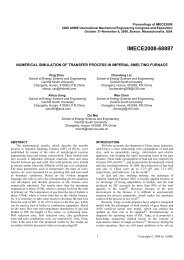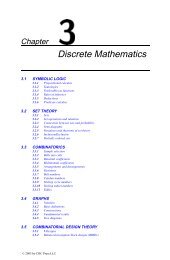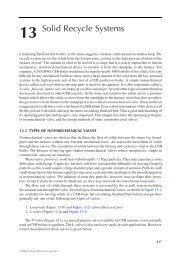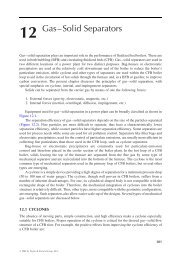Chapter 4: Geometry
Chapter 4: Geometry
Chapter 4: Geometry
You also want an ePaper? Increase the reach of your titles
YUMPU automatically turns print PDFs into web optimized ePapers that Google loves.
FIGURE 4.17<br />
Hyperbola with transverse semiaxis and conjugate semiaxis . Here ¼.<br />
¼<br />
Ý<br />
<br />
´¼µ<br />
¼<br />
Ç<br />
<br />
Ü<br />
´ ¼µ<br />
The Ü-axis is the transverse axis, and the Ý-axis is the conjugate axis. The<br />
vertices are the intersections of the transverse axis with the hyperbola and have coordinates<br />
´ ¼µ and ´ ¼µ. The segment thus determined, or its length ¾, is also<br />
called the transverse axis, while the length ¾ is also called the conjugate axis. The<br />
distance from the center to either focus is Ô ¾ · ¾ , and the difference between the<br />
distances from a point in the hyperbola to the foci is ¾. The latera recta are the<br />
chords perpendicular to the transverse axis and going through the foci; their length<br />
is ¾ ¾ . The eccentricity is Ô ¾ · ¾ . The distance from the center to either<br />
directrix is ¾ Ô ¾ · ¾ . The legs of the hyperbola approach the asymptotes, lines<br />
of slope ¦ that cross at the center.<br />
All hyperbolas of the same eccentricity are similar; in other words, the shape<br />
of a hyperbola depends only on the ratio . Unlike the case of the ellipse (where<br />
the major axis, containing the foci, is always longer than the minor axis), the two<br />
axes of a hyperbola can have arbitrary lengths. When they Ô have the same length, so<br />
that , the asymptotes are perpendicular, and ¾, the hyperbola is called<br />
rectangular.<br />
The simplest analytic form for the parabola is obtained<br />
when the axis of symmetry coincides with one coordinate<br />
axis, and the vertex (the intersection of the axis with the Ý<br />
<br />
curve) is at the origin. The equation of the parabola on the<br />
right is<br />
Ý ¾ Ü (4.6.3)<br />
´ ¼µ<br />
where is the distance from the vertex to the focus, or, which<br />
Ü<br />
is the same, from the vertex to the directrix. The latus rectum<br />
is the chord perpendicular to the axis and going through the<br />
focus; its length is . All parabolas are similar: they can be<br />
made identical by scaling, translation, and rotation.<br />
© 2003 by CRC Press LLC










